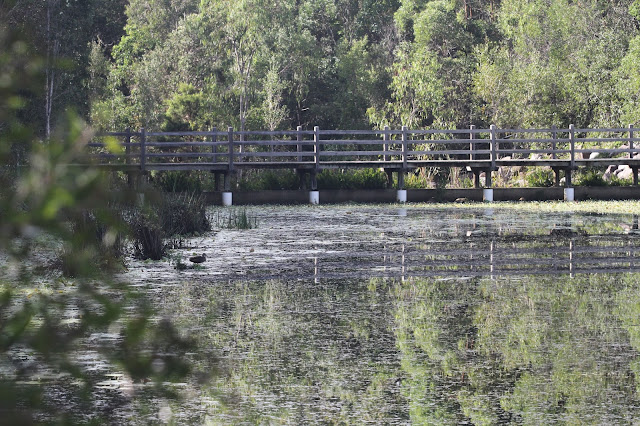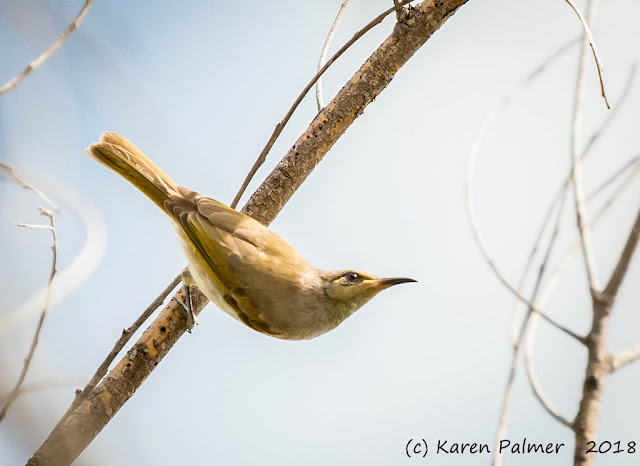 |
| Photo by Trina McLellan; For more of Trina's photography and environmental work, visit Nature Watch - Albany Creek. |
After 48 hours of torrential rain, I was relieved to be woken by sunlight last Sunday morning, the day of a Wild BNE meet-up that I had been planning for weeks!
Seven dedicated wildlife fans came out to join me at North Lakes, where we explored a small lagoon and an adjacent environmental park for an hour-and-a-half.
 |
| Swamp banksia (Banksia robur), by Karen Palmer. For more of Karen's photography, visit Wildlife in The Gap. |
First up was a look at some interesting bush plants, including the midyim berry (Austromytus dulcis) and the yellow prickly moses (Acacia hubbardiana).
The former plant is a popular bushtucker species, while the latter is an unusual wattle that reaches its southern distribution limit in the Moreton Bay Regional Council area.
Next, I took the group to a meat ant (Iridomyrmex purpureus) nest where we examined these industrious mound-builders, Renate a little more closely than the rest of us! 😄
 |
| Meat ant nest, by Trina McLellan; for more of Trina's photography and environmental work, visit Nature Watch - Albany Creek. |
The nests of these creatures are quite impressive structures made from small pebbles; John observed some ants carrying these pebbles out of the underground chamber openings, perhaps doing some maintenance after the heavy rain.
Meat ants are also one of few Australian animals that have taken to having cane toads (Rhinella marina) in their diet, though only the little ones that have recently completed the tadpole stage of their lifecycle.
 |
| Badge huntsman spider by Iskander Avidyananda; For more of Iskander's photography, visit The Weird Wild: a Natural History of Oz. |
Iskander did a great job of finding other invertebrates for us to see, in the form of various spiders.
A pale-coloured badge huntsman (Neosparassus sp.) in the foliage of a shrub was an intriguing find.
While many huntsman species are big fans of us humans, adapting to our home environments and showing a high tolerance to our presence, shield huntsman spiders just want to be left alone in the bush, and react to a close approach by raising their forelegs and showing their fangs.
Several gorgeous jumping spiders were also found and identified by Iskander, and these were much friendlier in disposition!
Particularly photogenic were some Bleeker’s jumping spiders (Euryattus bleekeri) hunting in the waterside vegetation.
 |
| Bleeker's jumping spider by Iskander Avidyananda; For more of Iskander's photography, visit The Weird Wild: a Natural History of Oz. |
The birdlife was admittedly somewhat ordinary however, a result of the flooding rains that have allowed waterbirds to be spoiled for choice, sending them far and wide.
Nevertheless, Trina had good views of a little black cormorant (Phalacrocorax sulcirostris) fishing in the lagoon, while Ros and John studied the diagnostic features of an intermediate egret (Ardea intermedia).
In the surrounding bushland, a brown honeyeater (Lichmera indistincta) showed off both its plumage and its song for Karen, and the whole group was treated to an appearance by the spangled drongo (Dicrurus bracteatus).
 |
| Brown honeyeater by Karen Palmer; For more of Karen's photography, visit Wildlife in The Gap. |
All in all, it was an enjoyable morning, thanks in part to the beautiful location and its wildlife and plants, but especially so because of the wonderful company.
Thank you Renate, Trina, Karen, John, Iskander, Ros and John for a great meet-up!
So what did you see on your hour and a half walk?
ReplyDeleteMaybe you just saw the 'preview' of this blog entry, David? The rest of the entry details what we found 😊
Delete